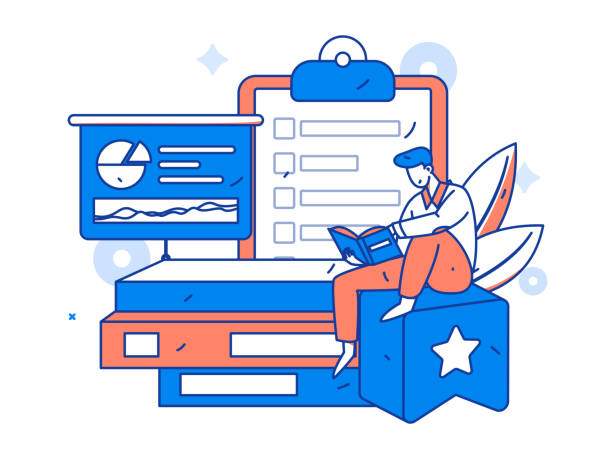Why is Fast Website Design More Crucial Than Ever Today?

In today’s digital world, website speed is not just an advantage, but an undeniable necessity.
#Website_Loading_Speed directly impacts #User_Experience and, consequently, your business’s online success.
Studies have shown that every second of delay in page loading can lead to a significant decrease in conversion rates.
Internet users don’t have much patience; if your website doesn’t load quickly, they will easily go to a competitor’s website.
This issue is especially critical for e-commerce websites, where every second can mean a lost sale.
Fast website design means ensuring that your visitors can access the information they need without interruption and have a positive experience on your website.
This is a comprehensive analysis of the needs of today’s users who seek instant access to content.
In addition to user experience, site speed is one of the important factors in Google’s SEO ranking.
Search engines prefer fast websites and place them higher in the results.
This is a specialized part of web optimization that requires special attention to infrastructure and coding.
Therefore, investing in fast website design not only increases customer satisfaction but also helps your website gain more visibility in search results.
This is an essential guide for any business that wants to remain competitive and grow in the online space.
The importance of this issue is such that many companies allocate significant resources to improving their website speed, as the return on investment from these optimizations is very high.
Understanding these basic principles is essential for any website manager or business owner.
Today, with the increasing use of mobile devices to access the internet, the need for fast website design has become more evident than ever.
Mobile users often use the internet at varying speeds, and a slow website can severely disrupt their user experience.
This is particularly challenging in areas with weaker internet infrastructure.
A fast website not only encourages users to spend more time on your site but also increases the likelihood of their return and conversion into loyal customers.
This is a thought-provoking question: Is your website ready to meet the expectations of modern users, including mobile users? To ensure this, we need meticulous planning and correct implementation of speed optimization techniques.
This includes choosing suitable web hosting, using a CDN, and optimizing images and scripts.
These aspects will be explored in more depth in subsequent sections.
Is your current e-commerce website design causing you to lose customers and sales?
Rasaweb is your solution with its modern and user-friendly e-commerce website designs!
✅ Significant increase in conversion rates and sales
✅ Strong branding and gaining customer trust
⚡ Get a free e-commerce website design consultation from Rasaweb!
Key Principles and Techniques for Website Speed Optimization

To achieve fast website design, one must adhere to a set of technical principles and techniques.
#Image_Optimization and #Code_Minification are among the first steps.
High-volume images can severely reduce page loading speed.
Using appropriate formats (such as WebP) and compressing them without losing quality is a crucial educational step.
This specialized section includes using online tools and graphic software to reduce file sizes.
Also, compressing HTML, CSS, and JavaScript files by removing white spaces and extra characters can significantly reduce the volume of transmitted data.
These processes, though they seem technical, have a significant impact on improving overall website performance and are considered initial steps in building a fast website.
Another important technique is the use of caching.
Caching allows browsers to store local copies of your website files, so that on subsequent visits, there is no need to reload all content.
This is a practical guide for reducing loading times for returning users.
Using plugins or server settings to enable caching can have a surprising impact on site speed.
Additionally, Lazy Loading for images and videos is also important.
With this technique, content is loaded only when it comes into the user’s view, rather than loading all page content at the beginning.
This approach significantly helps with fast website design, especially on long pages with extensive multimedia content.
Choosing a powerful and optimized hosting is also vital for achieving high speed.
A slow or unconfigured server cannot provide optimal speed, no matter how optimized your website is.
Fast website design starts with high-speed web hosting.
Hostings that support SSD and HTTP/2 are better choices.
Also, using Content Delivery Networks (CDNs) to distribute your website’s content through various servers worldwide minimizes latency and ensures users receive content from the closest server to them.
This is an analytical and infrastructural solution especially recommended for websites with global audiences or high traffic.
Correct implementation of these techniques lays the foundation for a truly high-speed website and significantly enhances the user experience.
Modern Tools and Technologies for Fast Website Design

Achieving fast website design has become much easier today with the help of advanced tools and technologies.
#Speed_Optimization_Tools and #New_Technologies play a key role in this process.
Using tools like Google PageSpeed Insights, GTmetrix, and Lighthouse to evaluate website performance and receive optimization suggestions is a crucial educational step.
These tools identify your website’s weaknesses and provide specific solutions for speed improvement.
This specialized information helps developers make more informed optimization decisions.
| Tool Name | Key Features | Main Focus | User Level |
|---|---|---|---|
| Google PageSpeed Insights | Scoring based on Core Web Vitals, optimization suggestions | Real and lab performance | Intermediate to advanced |
| GTmetrix | Scoring, request waterfall, visual timeline | Deep performance analysis | Intermediate to advanced |
| Pingdom Tools | Displays loading time, page size, number of requests | Global speed monitoring and testing | Beginner to intermediate |
| Lighthouse (Chrome DevTools) | Comprehensive reports on performance, accessibility, SEO, best practices | Comprehensive and automated audit | Intermediate to advanced |
In addition to testing tools, new technologies have emerged for high-speed website design.
HTTP/2, which is a more advanced version of the HTTP protocol, significantly increases page loading speed by allowing multiple requests to be sent simultaneously over a single connection.
The use of HTTP/2 by both server and browser is one of the best modern practices in website speed improvement.
Also, Progressive Web Apps (PWAs), which combine the best features of web and native applications, offer a very fast user experience and offline capabilities.
These technologies are considered innovative guidelines in web development.
The Accelerated Mobile Pages (AMP) technology is also designed to deliver incredibly fast content on mobile devices.
AMP, by using a restrictive HTML, CSS, and JavaScript framework, ensures that pages load in a fraction of a second.
This technology is particularly useful for news and content websites that require very high speeds on mobile.
This approach is a thought-provoking topic regarding extreme optimization for speed, but its benefits in mobile user experience are undeniable.
Finally, server-side optimization, such as using server-side caching and optimized databases, is also part of fast website design solutions.
These points have been highlighted as important news in the world of web development and should be considered in the planning of any project.
The Impact of Site Speed on SEO and User Experience (UX)

As previously mentioned, fast website design has a direct impact on #SEO_Improvement and #User_Experience.
Search engines like Google consider page loading speed as an important ranking factor.
Websites that load faster have a greater chance of achieving higher rankings in search results.
This is an explanation that demonstrates the technical importance of optimization.
Google, with the introduction of Core Web Vitals, has provided specific metrics for measuring user experience (including loading speed) that directly impact SEO.
Therefore, site speed optimization is crucial not only for your users but also for search engines.
From a user experience perspective, site speed directly affects your visitors’ satisfaction.
A slow website can frustrate users and quickly drive them away from your site.
This means an increase in the Bounce Rate and a decrease in the user’s time spent on the site.
In contrast, a high-speed website provides a smooth and enjoyable experience for users, leading to increased engagement, more page views, and ultimately, higher conversion rates.
This is an important analysis of user psychology in the online space.
Fast website design is a fundamental step in building a user-friendly website that can directly impact your business’s revenue generation.
Imagine a user is looking to buy a specific product.
If your website is slow, they will likely quickly move to a competitor’s website that offers a better user experience (including higher speed).
This not only means a lost sale but may also result in that user never returning to your website.
This is a thought-provoking question about customer loyalty, which depends on your website’s loading speed.
Therefore, investing in fast website design is, in fact, an investment in SEO, user experience, and ultimately, the sustainable growth of your online business.
This is a strategic guide for any business seeking long-term success in the digital space.
Are you worried about losing customers because you don’t have a professional e-commerce site?
With Rasaweb’s e-commerce website design services, forget these worries!
✅ Significant increase in sales and conversion rate of visitors to customers
✅ Professional and user-friendly design that gains customer trust
⚡ Get a free consultation from Rasaweb!
Common Web Design Errors and Ways to Combat Site Slowness

Despite the importance of fast website design, many websites still face the problem of slow speed.
This slowness often results from #Common_Design_Errors and #Incomplete_Optimization.
One of the most common errors is the lack of image optimization.
Using images with inappropriate dimensions and sizes, without compression, can severely reduce page loading speed.
This is an important educational step that should be considered in the initial stages of design.
The solution to this problem is to use image compression tools and choose modern formats like WebP.
Another error is the excessive use of unnecessary plugins and scripts.
Every extra plugin or script requires more resources and can increase page loading time.
This is a thought-provoking question: Are all the plugins you’ve installed truly essential for your website? Periodically reviewing plugins and removing unnecessary ones is a practical guide to improving speed.
Also, disorganized coding and using uncompressed and un-minified CSS and JavaScript codes lead to site slowness.
Optimizing codes and removing dead codes are an important part of fast website design.
Choosing an unsuitable and cheap hosting can also be the main reason for website slowness.
Shared hostings with limited resources are not suitable for websites with high traffic or specific requirements.
This is an important analysis in choosing website infrastructure.
Investing in a strong dedicated hosting or VPS can make a significant difference in website speed.
Not using caching and CDN is also a common error that negatively impacts site speed.
These points are significant news in the field of web optimization and should be considered in the strategy of fast website design.
Fixing these errors will be fundamental steps towards significantly increasing your website’s speed and performance.
Mobile-First Design and Its Impact on Website Speed

In the current era, where most users access the internet via mobile devices, #Mobile-First_Design and #Responsiveness play a crucial role in fast website design.
Google also places a strong emphasis on mobile user experience and ranks websites optimized for mobile higher.
This is a crucial educational step that every web developer should consider.
The mobile-first approach means that website design and development begin for mobile devices first, and then adapt for larger screens (desktop).
This approach naturally contributes to high-speed website design because designers and developers are forced to consider resources, file sizes, and performance in more limited mobile environments from the outset.
This includes optimizing images for smaller displays, using lighter code, and avoiding heavy animations that can reduce loading speed on mobile.
A properly implemented responsive website provides an optimal user experience on any screen size, without the need for separate versions.
This is a comprehensive explanation of the importance of website compatibility with various devices.
Correct implementation of mobile-first design and responsiveness helps reduce page loading time on mobile devices and decreases the bounce rate.
This issue gains more importance especially in areas with less access to high-speed internet.
A mobile-first and fast website not only provides a better user experience but also helps improve SEO and increase traffic from mobile devices.
This is important news for businesses, indicating that the future of the web is in mobile.
Consequently, focusing on fast website design through a mobile-first approach is a smart strategy for success in today’s digital world and is generally considered an effective guide.
Continuous Monitoring and Maintenance to Preserve Optimal Website Speed

After fast website design, the work is not over.
#Continuous_Monitoring and #Regular_Maintenance are essential for maintaining optimal website speed.
Websites may slow down over time due to adding new content, installing plugins, updates, and changes in traffic.
This is a thought-provoking question: Is your website regularly checked to maintain optimal speed? Using website speed monitoring tools that automatically check site performance and notify you of any issues is a key tip.
| Maintenance Item | Description | Frequency (Suggested) |
|---|---|---|
| Website Speed Check | Using Google PageSpeed Insights, GTmetrix | Weekly or Monthly |
| Database Optimization | Deleting unnecessary data and optimizing tables | Monthly |
| Updating Plugins and CMS Core | Ensuring compatibility and performance improvement | As soon as an update is released |
| Checking Broken Links and Redirects | Reducing HTTP errors and optimizing routing | Quarterly |
| Optimizing New Images | Ensuring proper compression and format for uploaded images | With every new content upload |
| Cache Clearing | Rebuilding cache to ensure up-to-date and fast content delivery | With every major site change |
Database optimization is one of the specialized aspects of maintenance.
Over time, the database can become filled with unnecessary information and old data, which reduces data retrieval speed.
Regular database cleaning and optimization can dramatically increase website speed.
This is an important educational step for website administrators.
Also, ensuring that the Content Management System (CMS), theme, and plugins are up-to-date is essential for maintaining website speed and security.
These updates often include performance and security improvements that contribute to site speed optimization.
Regular backups of the website and database are also a vital maintenance step.
This not only ensures the security of your data but also allows for reverting to a previous, healthy version if any issue arises that leads to site slowness.
This is important news that should always be considered.
Finally, training the website team on best practices for content upload (such as optimizing images before uploading) can also help maintain fast website design in the long run.
This is an analytical approach to website management that leads to sustained performance.
The Role of Content and Media in Site Loading Speed

Content and media on a website are very important factors that can directly impact #Loading_Speed and #Site_Performance.
#Content_Optimization is a key aspect of fast website design.
High-quality images, videos, and audio files can enrich the user experience, but if not properly optimized, they can severely slow down your website.
This is a thought-provoking question: Does your content reduce site speed instead of enhancing appeal?
Images are the biggest speed reduction factor on many websites.
Using high-resolution images with dimensions larger than actually needed leads to an increase in page size and, consequently, slower loading.
The solution to this problem is image compression optimally and using modern formats like WebP, which preserve quality while significantly reducing file size.
Also, using the Lazy Loading technique for images and videos, where content is loaded only when it enters the user’s view, greatly helps improve speed.
This is a practical and educational guide for content creators.
Videos and audio files can also be very heavy.
Instead of directly hosting videos on your server, using platforms like YouTube or Vimeo and embedding them on your website can offload a significant burden from your server and improve loading speed.
This is a specialized recommendation that helps increase website efficiency.
Additionally, compressing audio files and using appropriate formats for them is also important.
Finally, even text volume can affect speed; although less so than images and videos.
Optimizing fonts and using the minimum necessary fonts also falls within the scope of fast website design.
These are important news for anyone looking to improve their website’s performance.
Research shows that 80% of customers trust companies with professional websites more. Does your current site gain this trust?
With Rasaweb’s corporate website design services, solve the problem of customer distrust and a weak online image forever!
✅ Create a professional image and increase customer trust
✅ Attract more sales leads and grow your business
⚡ Get a free consultation!
The Future of Fast Website Design: Progressive Web Apps (PWAs) and AMP

The future of fast website design is strongly tied to technologies like #Progressive_Web_Apps (PWAs) and #Accelerated_Mobile_Pages (AMP).
These technologies, both aiming to provide a fast and seamless user experience, play an important role in the evolution of the web.
PWAs are essentially a combination of the best features of websites and native applications.
They can work offline, send Push Notifications, and offer a user experience similar to mobile applications.
This is a thought-provoking topic that blurs the line between web and application, and is considered a new guide for web developers.
The main advantage of PWAs is their high speed.
By using Service Workers for caching content and assets, PWAs can quickly load content even in poor or no internet connection conditions.
This approach greatly contributes to building a high-speed website and elevates the user experience to a new level.
They also have the ability to be installed on the device’s home screen, without the need for downloading from app stores, which makes access much easier for users.
This is important news in the field of web development, indicating a bright future for web applications.
On the other hand, AMP (Accelerated Mobile Pages) is an open-source framework developed by Google for creating incredibly fast web pages on mobile devices.
The main goal of AMP is to deliver content at near-instant speed.
AMP achieves this by restricting HTML, CSS, and JavaScript and optimizing resource loading.
This is a specialized solution for websites that require very high speed for news articles or blog content.
Although AMP may impose some design limitations in certain cases, its unparalleled speed on mobile is undeniable.
This is a complete explanation of how AMP works to achieve fast website design.
Both PWA and AMP technologies demonstrate the web industry’s commitment towards speed and efficiency.
While PWA is a more comprehensive solution for the overall website experience, AMP is more suitable for static and fast content.
The choice between them depends on the type of website and its goals.
But both play a vital role in the future of fast website design and, overall, represent an analysis of future web trends.
Optimizing Code and Resources for Maximum Speed

One of the highly specialized yet crucial aspects of fast website design is the precise optimization of website code and resources.
#Code_Minification and #JavaScript_Optimization are among the key measures in this area.
Removing white spaces, comments, and extra characters from HTML, CSS, and JavaScript files (known as Minification) can significantly reduce the size of these files and, consequently, improve loading time.
This is a fundamental educational step for any developer seeking optimal performance.
JavaScript, due to its nature, can impose a significant load on the user’s browser and reduce page rendering speed.
Optimizing JavaScript code through techniques like Deferring Parsers or Async Loading for non-essential scripts allows the browser to display the main content of the page before all scripts are fully loaded.
This improves user experience and makes the website appear faster.
This is an important technical guide for achieving high-speed website design.
Additionally, using CSS-in-JS or CSS Modules can also help reduce the size of CSS files.
Furthermore, font optimization is also of great importance.
Using too many fonts or fonts in unsuitable formats (such as TTF instead of WOFF2) can increase page loading time.
Optimizing fonts through compression and the use of modern formats, as well as loading only a subset of characters that are actually used (Font Subsetting), can help improve speed.
This is a detailed explanation of how to reduce resource load.
Finally, cleaning up and organizing old or unnecessary code (Dead Code Elimination) also helps reduce the overall code size and improve performance.
These are specialized aspects of fast website design that require technical knowledge, but their results in website performance are remarkable and are considered important news in web development.
Frequently Asked Questions
| Question | Answer |
|---|---|
| What does fast website design mean? | Optimizing a website for quick page loading in users’ browsers, which leads to a better user experience and higher search engine rankings. |
| Why is website loading speed important? | Increased user satisfaction, reduced bounce rate, improved SEO, and increased conversion rates, as users expect websites to open quickly. |
| What factors affect site speed? | Image size, unoptimized coding (CSS, JS, HTML), unsuitable hosting choice, lack of caching, high number of HTTP requests, and not using a CDN. |
| How can website loading speed be improved? | Image compression, code optimization and minification, using caching, enabling Gzip compression, using a CDN, and choosing powerful hosting. |
| What is a CDN and how does it help website speed? | A CDN (Content Delivery Network) stores website content on various geographical servers, and the server closest to the user delivers the content, which reduces loading time. |
| How significant is hosting’s role in website speed? | Very significant. Powerful and suitable hosting with sufficient resources, high bandwidth, and optimized servers forms the foundation of a website’s speed. |
| How does image optimization affect site speed? | Images are usually the heaviest part of a web page. Compressing and optimizing them without significant quality loss greatly reduces page size and increases loading speed. |
| Does site speed affect SEO? | Yes, Google and other search engines consider site speed as one of the ranking factors. Faster sites have a greater chance of higher rankings. |
| What tools are available for measuring site speed? | Google PageSpeed Insights, GTmetrix, Pingdom Tools, and Lighthouse, each providing reports and suggestions for speed improvement. |
| How does caching help site speed? | Caching causes static site content to be stored for subsequent user visits. As a result, the browser does not need to re-download all content, and pages load much faster. |
And other advertising services of Rasaweb Advertising Agency
Smart Digital Advertising: Professional optimization for improved SEO ranking using intelligent data analysis.
Smart Google Ads: A combination of creativity and technology to improve SEO ranking through custom programming.
Smart Marketing Automation: Designed for businesses seeking online growth through user experience customization.
Smart Content Strategy: A combination of creativity and technology to increase site traffic through Google Ads management.
Smart Advertorials: An effective tool for campaign management with the help of SEO-driven content strategy.
And over hundreds of other services in the field of internet advertising, advertising consultation, and organizational solutions
Internet Advertising | Advertising Strategy | Advertorials
Sources
The Importance of Site Speed in Business Success
Modern Web Design Methods
Impact of Fast Site on SEO and Business
Website Design and Business Success
? Is your business ready to leap into the digital future? Rasaweb Afarin Digital Marketing Agency, by offering comprehensive services including modern UI website design, SEO, and social media management, paves your path to success. Contact us today and transform your brand’s future.
📍 Tehran, Mirdamad Street, Next to Central Bank, Southern Kazeroun Alley, Ramin Alley, No. 6




